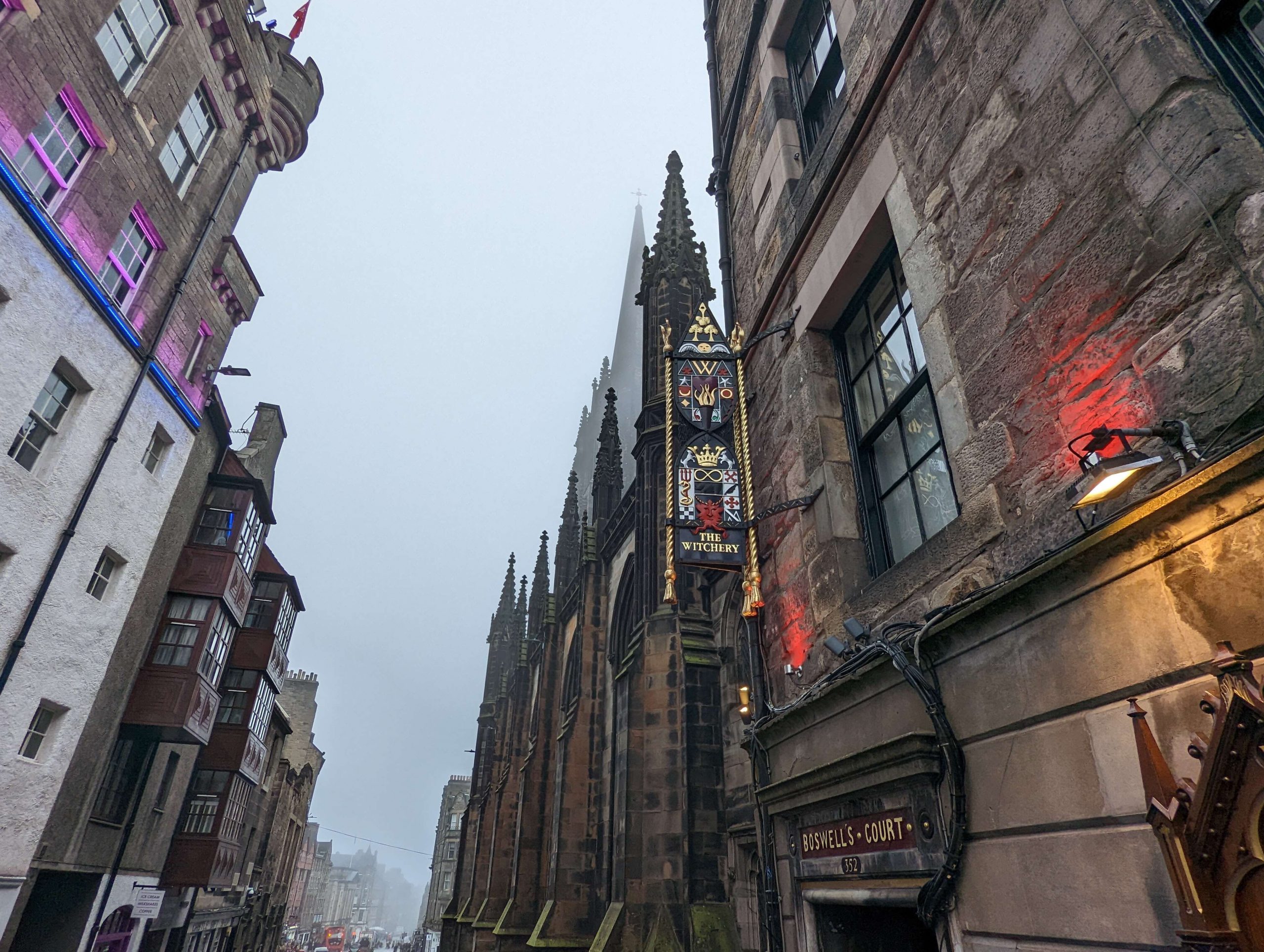Edinburgh is a bustling historical city that offers so much to see and do. The main focus of our visit was to experience the wonderful historical landmarks and learn more about them. Check out our video vlogs of our experience in Edinburgh here too.
Princes Street Gardens
We arrived in Edinburgh late afternoon and began our weekend with a stroll along the Princes Street Gardens. Amazingly, the gardens are one of many parks and green areas situated in this busy city.
Princes Street Gardens separates Edinburgh’s New and Old Town, however it was not always a beautiful luscious green space, it was once a loch called Nor Loch and formed part of the cities mediaeval defences.
You might also be surprised to discover that the loch was no delightful area for a stroll or picnic, it was a stinking cesspit. The loch was used to dump the city’s waste and was a notorious spot for dumping dead bodies, it is also believed that during the notorious witch trials, Nor Loch was the site used for ‘witch ducking’ (a horrific method used to ascertain whether a person was a witch or not).
In the 1770’s it was decided that Nor Lock should be drained and transformed into gardens but this process was not completed until 1820’s.
The gardens have lovely views and it was here that we got our first glimpse of Edinburgh Castle standing prominently on top of Castle Rock. Strolling through the gardens there are many monuments and statues that are worth checking out.

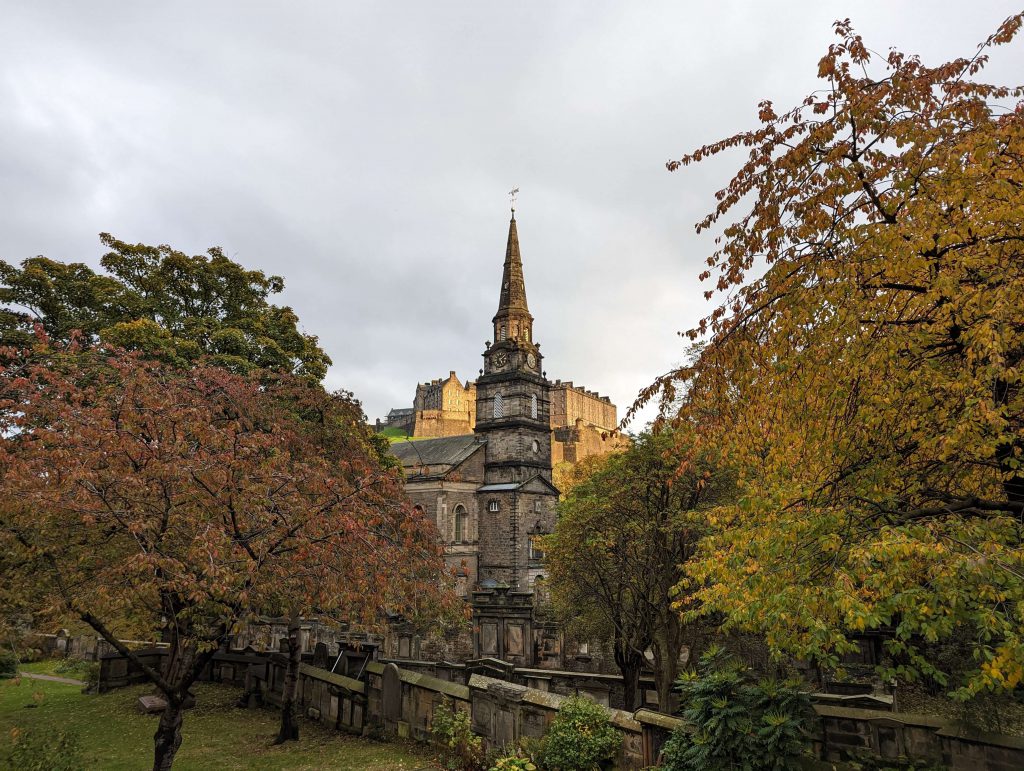
Sir Walter Scott Monument
The Walter Scott Monument is situated in the Princes Street Gardens. The Victorian gothic monument was constructed in 1832 by George Meikle Kemp, it stands at 61.11m (200 feet 6 inches) making it the second largest monument in the world to a writer.
The monument has various viewing platforms and a total of 287 steps to reach the highest (there is an admission charge to climb the monument (we did not as it was late when we arrived), more info at https://www.edinburghmuseums.org.uk/venue/scott-monument )
If you look closely at the monument you might be able to spot some of the 64 figures that all depict characters from Scott’s novels.
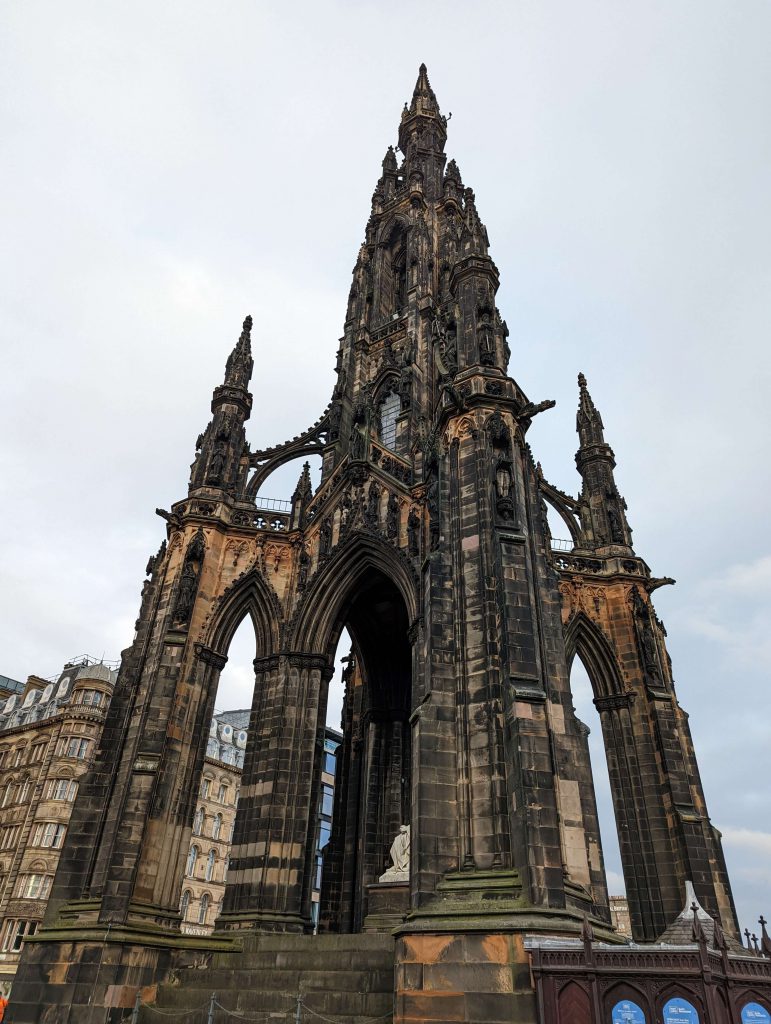

Royal Mile
The Royal Mile runs between Edinburgh Castle and The Palace of Holyroodhouse. Its length is approximately one Scots mile (1.81 km). It is not one street but a succession of five streets, Castlehill, the Lawnmarket, the High Street, The Canongate and Abbey Strand.
The Royal mile is always bustling with tourists and for a good reason. It is situated in the centre of Edinburgh’s Old Town and crammed full of historical buildings which now house museums, tourist attractions, restaurants, shops and cafes. It is quite easy to spend a great deal of time just browsing through these shops and gazing at the magnificent buildings.
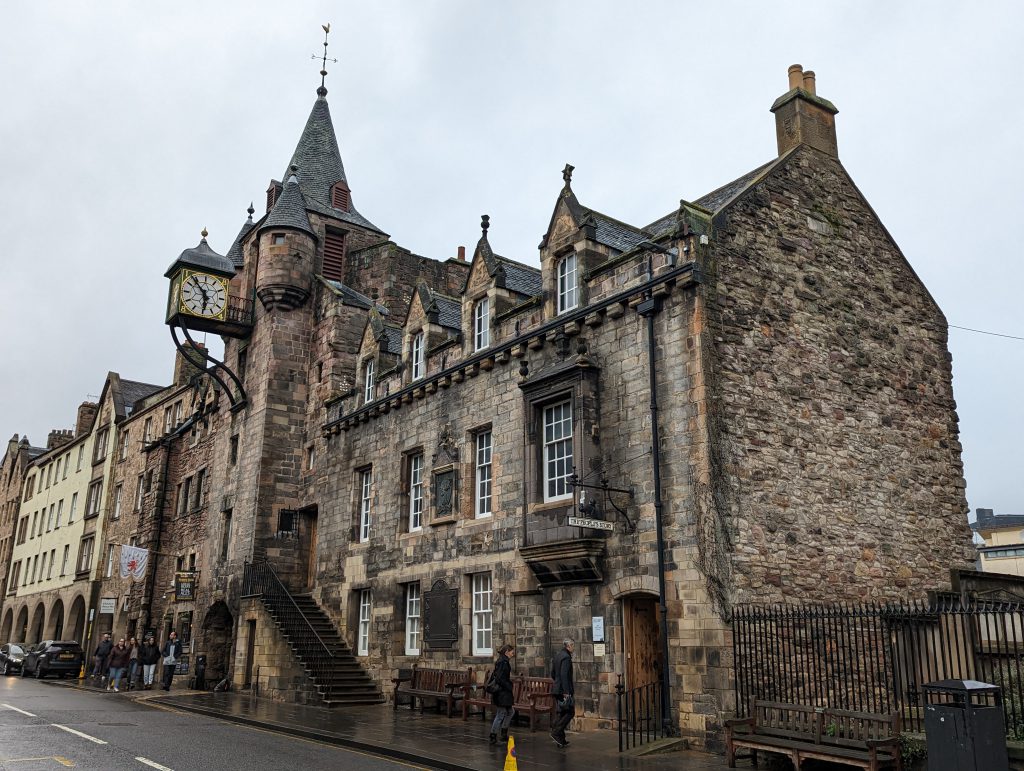
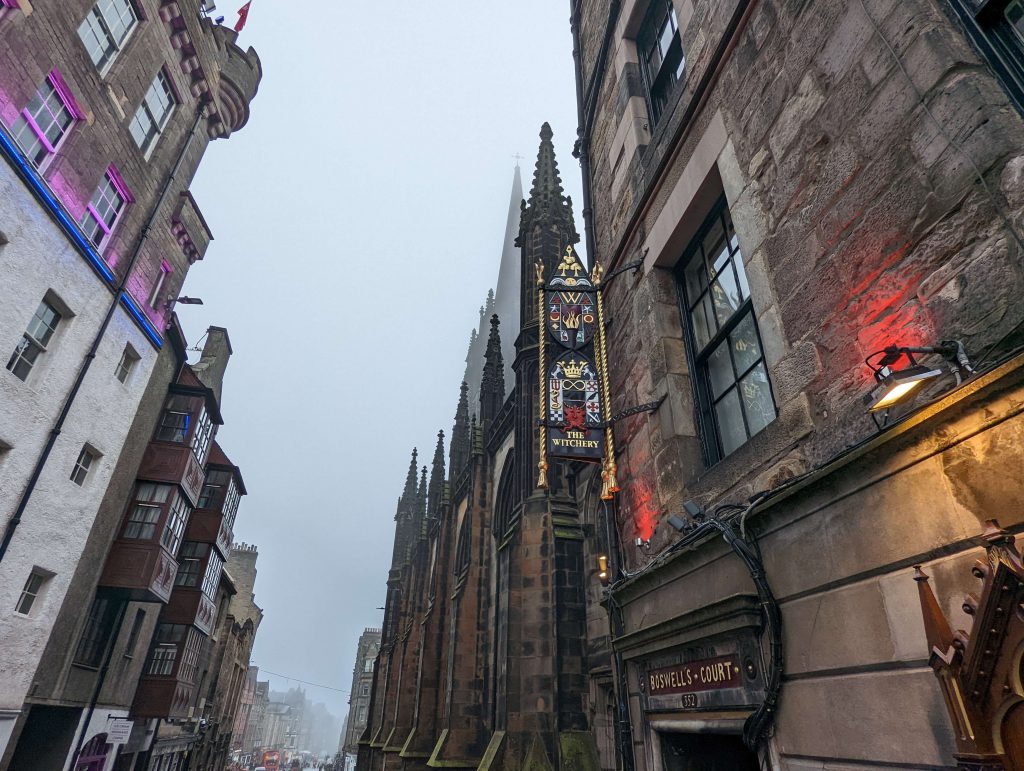
Closes
Edinburgh closes are tiny narrow streets or alleyways that lead off the Royal Mile. They were generally named after a memorable resident or trade. Some of these closes are closed off now as they lead to private property, but many still lead to courts and cafes and discovering where they go is rather fun.
Mary King’s Close is now a popular tourist attraction which we visited. It is claimed that during the plague outbreak in the 17th century it was used as a quarantine in an attempt to stop the spread of the disease. The spirits of those that succumbed to the terrible plague supposedly haunt the close.
Palace of Holyroodhouse
The palace is located at the bottom of the Royal Mile (the opposite end to Edinburgh Castle) and since the 16th century it has served as the principal Scottish residence of the British Monarch.
The west range was remodelled in 1633 for the coronation of Charles I at Holyrood Abbey and Charles resided there until November 1641. Repairs and a full survey was carried out by 1663 and the Privy Council decided to completely rebuild the palace in 1670 which was paid for by the Council rather than by Charles II who was running low on funds.
In 1822 during his visit to Scotland, King George VI became the first reigning monarch to visit the Palace since Charles I in 1641. He ordered repairs to be made on the Palace and between 1824 and 1834, changes include the demolition of all the outlying builds to the north and south and the reducing of the south front.
From 1854 the historic apartments in James V’s tower were formally opened to the public.


From the beginning of George V’s reign in 1910 he began transforming Holyroodhouse into a modern palace, adding central heating, electric lighting, modern kitchens and new bathrooms.
The palace was formally designated as the monarch’s official residence in Scotland and homed regular royal ceremonies and events. Elizabeth II spent one week there each summer during her reign.
Holyroodhouse remains the property of the Crown, with conservation and maintenance falling to the Scottish Government through Historic Environment Scotland.
The interior of the palace is incredibly grand and wonderful artwork is on show in the palace gallery. Outside are the ruins of the abbey and delightful gardens. Holyroodhouse is definitely worth visiting. Ticket booking information is at the official Palace of Holyroodhouse website.
Heart of Midlothian
Just outside of St Giles’ on the Royal Mile is the mosaic Heart of Midlothian. It is considered to bring good luck if you spit upon it. This is quite a contrast to the reason why locals once spat upon the spot. The Heart marks the location to the entrance to the Old Tollbooth, which was a notorious prison and place of public executions. It is believed that locals originally spat on the spot to express their loathing at the terrible deeds that the inmates had committed.


St Giles’
St Giles’ is situated on Edinburgh’s Royal Mile and was founded in 1124 by King David I. Only fragments remain of the original church as it was much altered and extended on from the late 14th century through and into the 16th century. Further remodelling occurred in the 19th century.
Surprisingly the church is not a cathedral, although it was twice in the past, the pope elevated the church to collegiate status in 1467 and 1559.
During the Scottish reformation the church moved from being Catholic to Protestant. Catholic decorations were removed including the church’s stained glass windows (later restored) and John Knox became minister.
In 1911, the famous neo-gothic Thistle Chapel was added to the church. The chapel is the home to the Knights of the Thistle, Scotland’s great order of chivalry.
The church is most impressive both on the outside and on the inside interior, with ornate gothic stonework, huge columns and glorious stained glass windows. Entry is free but donations are appreciated at the church.


National Museum of Scotland
The National Museum of Scotland is a gigantic museum packed with exhibits. If you want to learn more about the history of Scotland then you are in the right place as there is a wealth of information over a number of floors. There are also international collections covering science and technology (a very interactive exhibit, great for children), natural history (guarded by the skeleton bones of a tyrannosaurus rex) and world culture.
Some notable exhibits for us were the ancient Egyptian collection, the stuffed body of Dolly the Sheep (first successful cloning of a mammal) and the huge kinetic Millennium Clock sculpture which when it chimes I found mesmerising.
Incredibly the museum entrance is free (donations if you can are appreciated by the museum). We only had a couple of hours to spare to explore but you could spend days gazing at the exhibits and still discover something new.


Edinburgh Vaults
Underneath Edinburgh Old Town lies a series of hidden chambers that date back to the 18th century and are known as Edinburgh Vaults or South Bridge Vaults. Edinburgh South Bridge was completed in 1788 and connected the Royal Mile High Street to Chambers Street. 19 arches were built to support the bridge and the vaults and chambers beneath the bridge were walled in and used as store rooms, workshops and taverns for approximately 30 years.
Construction of the bridges had been rushed and the vaults began to flood and were extremely damp which led to them being abandoned by the businesses. Local criminals took this opportunity to utilise them for their wicked dealings and the very poorest and homeless took shelter down in the dark chambers (it was actually illegal to be homeless in Edinburgh from 1824). Living conditions down in the vaults were terrible and disease spread rapidly.
It is not known when the vaults complex was closed down but in the 1980’s it was rediscovered and excavated. The site is reportedly a hotspot for paranormal activity with a number of television programs and books investigating the strange happenings.
The vaults are closed off for general public access but a number of tour companies offer guided tours. We joined the “Double Dead Tour” by City of the Dead Tours which showed us around the South Bridge Vaults and then on to the Covenanter’s Prison in Greyfriars Graveyard. There was a mixture of history and ghost stories. Down in the vaults there is little light and it has a very creepy atmosphere (we had one member of the group faint during the tour) and we were told of many stories of previous tourists’ eerie experiences down there.
I had been for some time very intrigued to visit these vaults for myself (I do like a good old forgotten site with secrets). The vaults are a maze of damp stone store rooms but it is the tales they have to tell that makes them so intriguing
Our tour lasted for two hours and cost £19.00 per person. If you are a Harry Potter fan then you might be interested to hear that J K Rowling took the names from numerous gravestones in Greyfriars Cemetery for her characters in Harry Potter.
At the end of the tour there was the option to have a look in the City of the Dead Tour’s office where you can purchase books, memorabilia and view a copy of the death mask of William Burke (Hare and Burke were notorious early 18th century serial killers in Edinburgh).
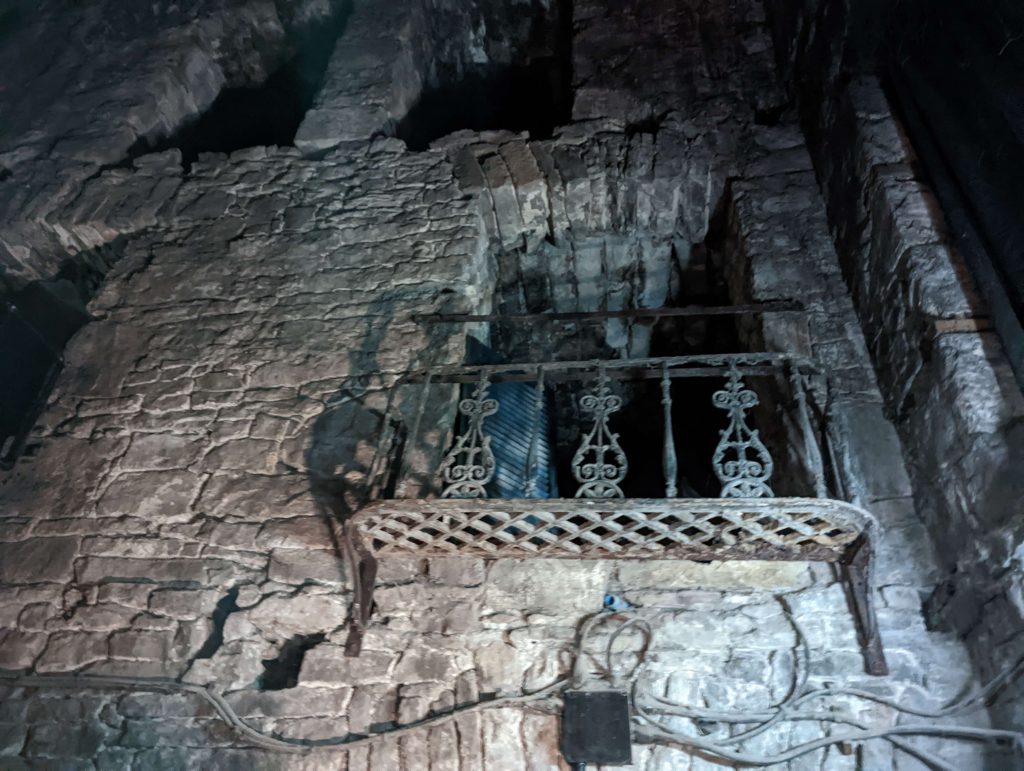

Edinburgh Castle
We pre-booked our tickets for Edinburgh Castle for the earliest slot in the day so as to try to get a good look around the castle before it became too crowded and I would also advise pre-booking your tickets to avoid disappointment as tickets often sell out. Click here to visit the official Edinburgh Castle website for ticket booking information.
The castle is situated proudly on top of Castle Rock, an extinct volcano. The site is believed to have been occupied for at least 3000 years and was a royal residence from at least 1093 until 1633. The castle’s main function after this was as a military base and today the castle houses The National War Museum, three regimental museums and The Scottish National War Memorial. Many battles have been fought at the castle, in fact it is the most besieged place in Great Britain.
Click here to read our detailed history of Edinburgh Castle

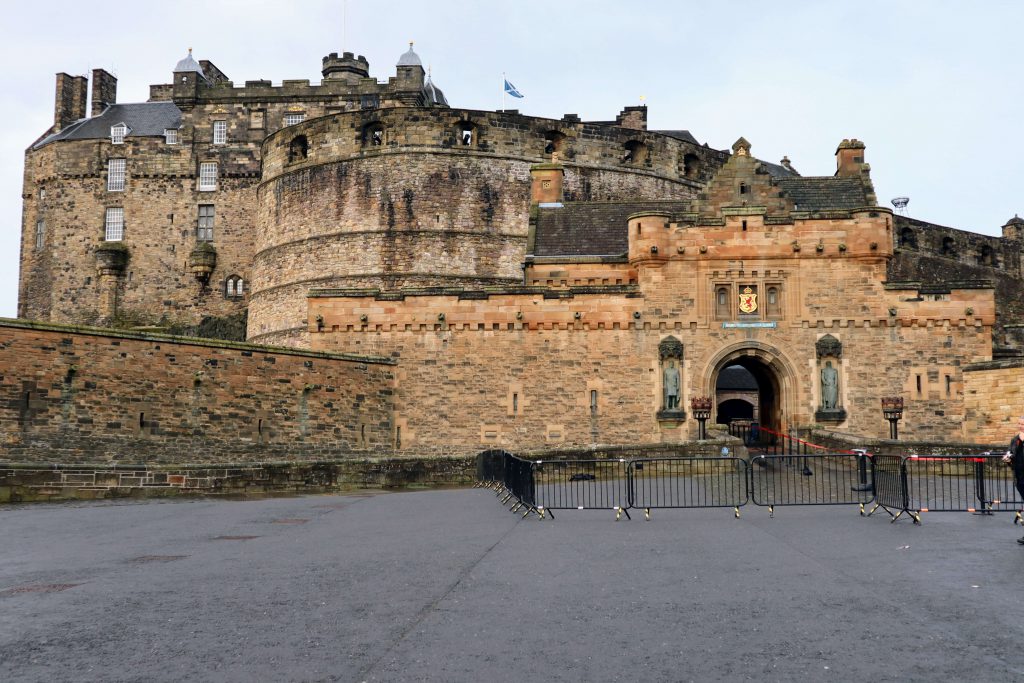
The One O’clock Gun
The One O’clock Gun is fired everyday (except Sundays, Christmas Day and Good Friday). It was first introduced in 1861 and its purpose was to aid ships navigation as the ships crew would know the exact time as in the 19th century clocks were not very accurate.
St Margaret’s Chapel
St Margaret’s Chapel is the oldest remaining structure in the castle. It was built in around 1130 by King David I who dedicated it to his mother, St Margaret.
Margaret died at the castle in 1093 from grief a few days after she learned that her husband, King Malcolm and eldest son had been killed fighting the English in Northumberland. She was canonised as a saint in 1250.
The chapel became redundant and was forgotten in the 1500’s and repurposed as a gunpowder store. Luckily the chapel was rediscovered in 1845 and restored.
Mons Meg
Mons Meg was the ultimate weapon of mass destruction of its day. It was forged in 1449 in Belgium and sent to King James II as a wedding present from the Duke of Burgundy, the bride’s uncle.
Mons Meg weighs an astounding six tonnes and is capable of firing a stone ball almost two miles.
David’s Tower
David’s Tower was built in the late 1300’s and once stood over 30m high. It was the Royal residence for over 100 years but it fell crashinging down at the end of the Lang Siege in 1573. There are some ruins left to explore but are partly obscured by later cellars.
The Royal Palace
From Crown Square you can enter the Royal Palace where the Honours Of Scotland and The Stone Of Destiny are housed (strictly no photography inside here).
The Honours of Scotland are the Crown, Sceptre and Sword of State and these are the oldest crown jewels in Britain. They were made in Scotland and Italy during the reigns of James IV (1438-1513) and James V (1513-1542). They were first used together for the coronation of Mary, Queen of Scots in 1543.
The Honours have had a rather dramatic history. In order to keep them out of English hands they have been hidden and buried under Dunnottar Castle and Kinneff Church and then locked away in a secret crown room in 1707. The room was completely forgotten and the Honours were presumed to be lost until in 1818 Walter Scott discovered their whereabouts.
The Stone of Destiny does not look much, a sandstone slab, but it is believed to be part of an ancient royal bench-throne that was used for centuries as part of the coronation of Scottish monarchs. The stone’s earliest origins are now unknown. In 1296, King Edward I of England removed the stone and took it to Westminster Abbey in London, where it stayed until it was returned on its 600th anniversary to Scotland.
The Great Hall
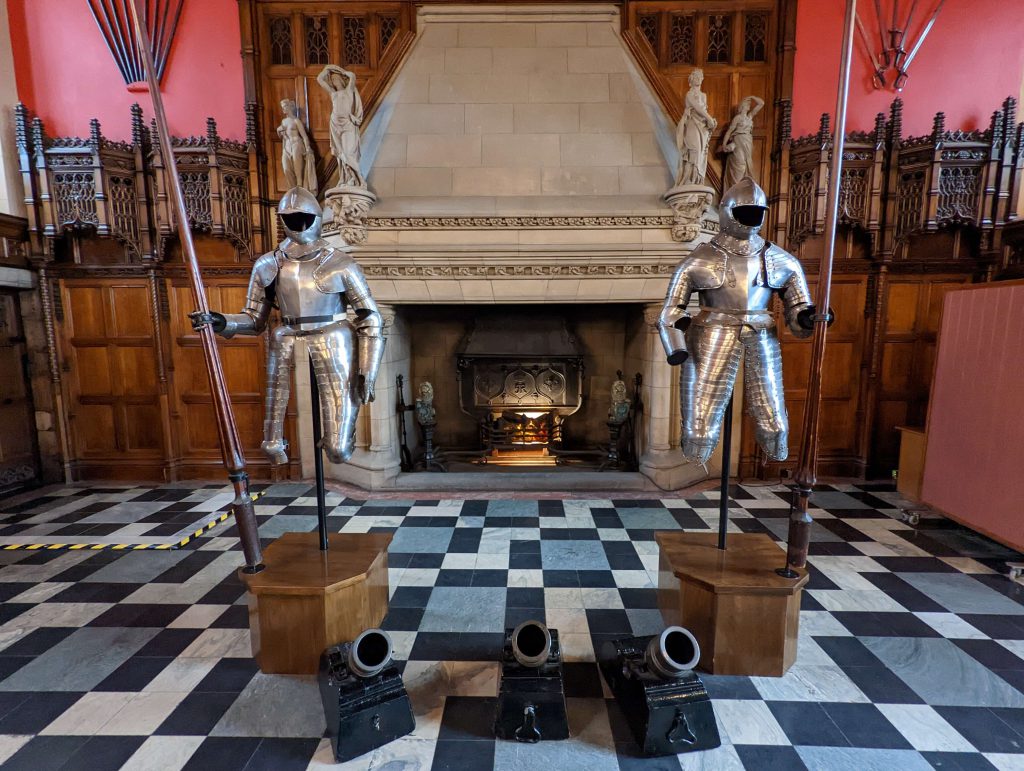

The Great Hall was built in 1512 for James IV as a place for royal ceremonies and banquets. If you look up you will see the magnificent original roof, which is the most impressive feature of the hall for me. The hall also served as a barracks and military hospital until restoration began in 1886.
You might notice the iron-barred grid above the fireplace on the right. This is a ‘laird’s lug’ (peephole) where the king could spy on his guests. When Mikhail Gorbachev visited the castle in 1984 the KGB asked for it to be bricked up.
Round Up
Edinburgh Castle is a fascinating site, full of history spanning a wide timespan, there is certainly a lot to take in. Standard adult admission is currently £18.00 per person, there are discounts for Historic Scotland, English Heritage, Cadw and Manx members. I would recommend keeping at least three hours free to explore the castle and as it is higher up on top of Castle Rock it gets quite windy and chilly. Audio guides are available to hire which provide detailed information throughout the site. The castle is the second most visited paid tourist attraction in the UK and we thoroughly enjoyed exploring Edinburgh Castle.
Click here to watch our video on the history of Edinburgh Castle
Gladstone’s Land (Tenement Buildings)
The tenement buildings in Edinburgh date back to the 17th century and have been described as the first skyscrapers in the world, as some reached 15 stories high. The tenement buildings were built in response to a housing crisis, Edinburgh’s population was vastly increasing and there was not enough space. The tenement buildings could house many large families and could be constructed quickly (often poorly built which led to some later terrible disasters when the buildings collapsed).
Gladstone’s Land is one of the oldest surviving tenement buildings on the Royal Mile. It was originally built in 1550 but in 1617 the building was bought and redeveloped by Thomas Gladstone. The Gladstone’s resided on the upper floors and let out rooms on the lower floors to tenants.
Gladstone’s Land fell into decline in the early 20th century and was rescued from demolition by the National Trust, who have owned it since 1934. The building was slowly restored and the first, second and third floors were developed into a museum that shows how the tenants lived over a number of time periods.

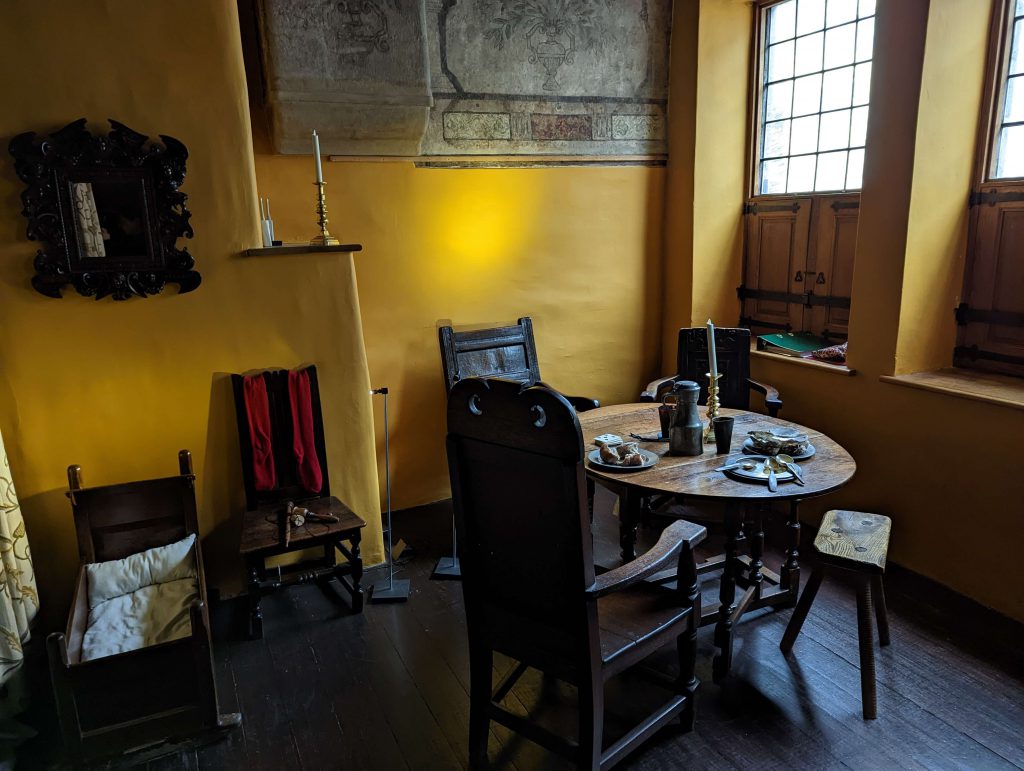
The third floor demonstrates Mary Wilson’s boarding house in 1911. Boarding house’s houses offered temporary accommodation and varied enormously in the amenities they offered and the class of residents. Mary Wilson’s boarding house was relatively comfortable and would have likely attracted working class men in stable jobs.
The second floor is set out as the draper’s shop that belonged to William Dawson and Elizabeth Pillands in 1766. They were both wealthy and would have sold high quality fabrics, ribbons and accessories to middle and upper-class women.
The first floor displays wealthy merchants John Riddoch and Margaret Noble’s living area in 1632. They also had a shop on the ground floor and tavern in the basement. They had expensive furniture and the hand painted ceiling was stunning.
Gladstone’s Land was fascinating and it was very interesting to view how these tenement buildings may have once looked on the inside, although Gladstone’s only displays how the wealthier side of society lived, many living in the tenements were incredibly poor and had much worse living conditions.
Visit the official website for Gladstone’s Land for opening times and ticket information.
Craigmillar Castle
Our final stop for the weekend was medieval Craigmillar Castle. It is located just outside of the city centre, approximately 3-4 miles and there is a small car park on site. Alternatively you can take a bus from the city centre, although there is a 15 minute walk from the bus stop to complete the journey. Click here to watch our video exploring Craigmillar Castle.
The oldest part of the castle is the four storey tower house, which forms part of the centrepiece of the castle and was completed by 1425. Click here to read our detailed history of Craigmillar Castle.
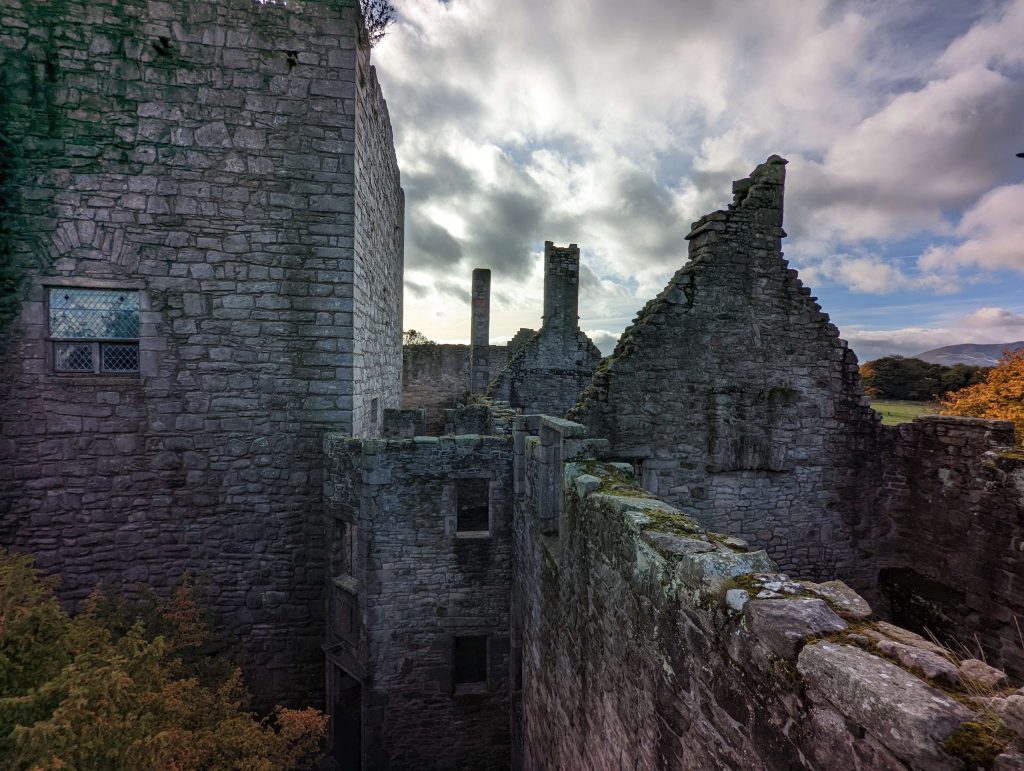

In the 16th century, the castle had one very high profile guest, Mary, Queen of Scots. Mary visited the castle on a number of occasions and she chose it as her place of sanctuary after falling ill following the birth of her son (future James VI).
It was during this visit that a pact, known as the Craigmillar Bond was made between the earls of Bothwell, Argyll and Huntly. The pact was a plot to dispose of Mary’s very unpopular husband, Henry Stuart, Lord Darnley. They hoped to lure Darnley to Craigmillar where their plans could be executed, but Darnley chose to stay at his house in Edinburgh, where he was found murdered in February 1567.
Mary then married Bothwell, who was involved in the plot to kill her previous husband. Whether this was her choice or she was forced to marry him is not known, but the marriage caused problems for her and rebellions began to take place which eventually led to her downfall.
The castle is classed as ruinous but a great deal of the structure is still intact. There are many rooms, nooks and crannies to explore, it feels rather like a maze. Despite being so close to the bustling city the castle has a very tranquil feel and the views from the tower house over Edinburgh are superb. If you want a break from the busy city centre and enjoy history then Craigmillar is the perfect place.
The castle is now looked after by Historic Scotland, standard adult admission is a very reasonable £7.00 (2022), there are discounts for Historic Scotland, Young Scot, English Heritage, Cadw and Manx members.

